What Is The Difference Between Selective Racking and Double Deep Racking?
When looking for the right type of storage rack for their warehouse, many investors are confused when comparing Selective racking and Double Deep racking because these two types of racking possess many similar characteristics. Let’s find out below in the following article to easily see the differences, thereby making the most reasonable choice for your warehouse!
Compare the characteristics of Selective racking and Double Deep racking
1.1 Structure
In terms of structure, these two types of racking are almost the same, both are made up of 7 basic details. However, the Double Deep racking is equipped with a guide rail to help guide the pallet when the forklift operates at high levels.
The following is a 3D drawing simulating these two types of racking:
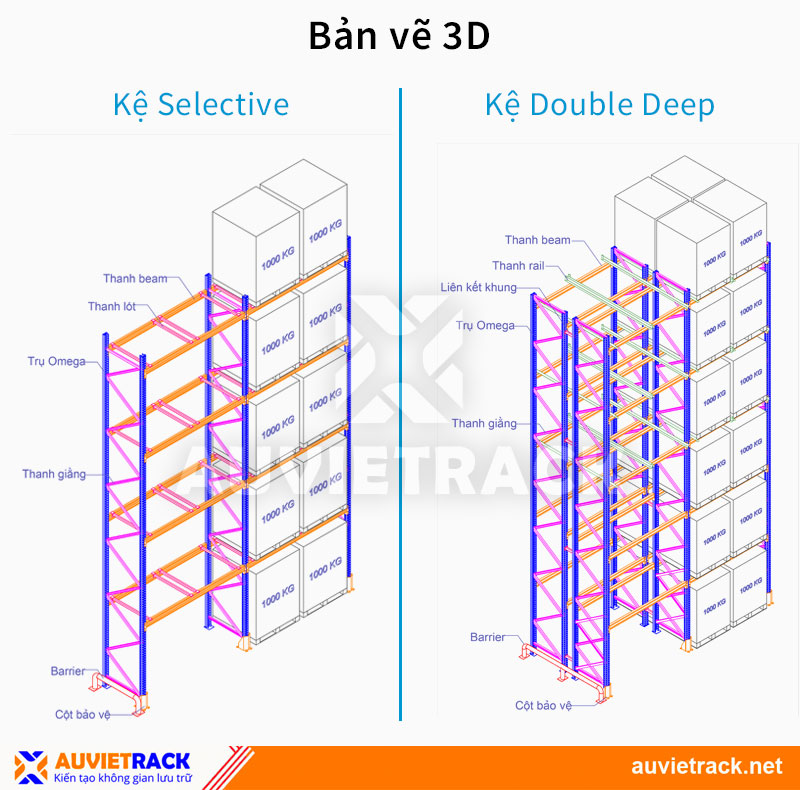 3D drawings of Selective racking and Double Deep racking
3D drawings of Selective racking and Double Deep racking
Below is a table listing the component details of Selective and Double Deep racking:
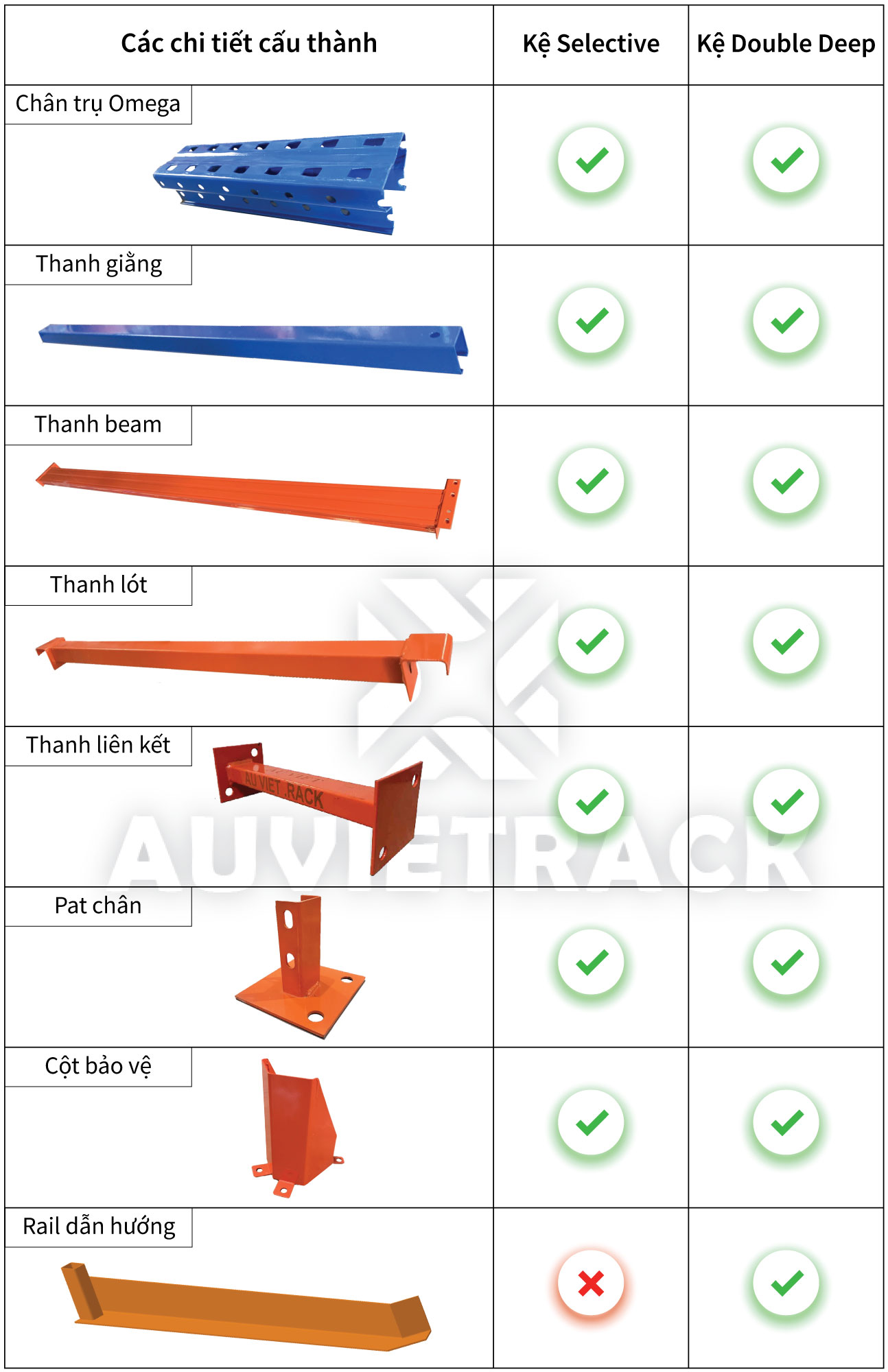 The table lists the structural details of Selective and Double Deep racking
The table lists the structural details of Selective and Double Deep racking
1.2 Loading capacity
Both Selective pallet racking and Double Deep racking are used to store goods from lightweight to very heavy. Normal load will be in the range of 300-2000kg/pallet. This is the similarity of these two types of racking.
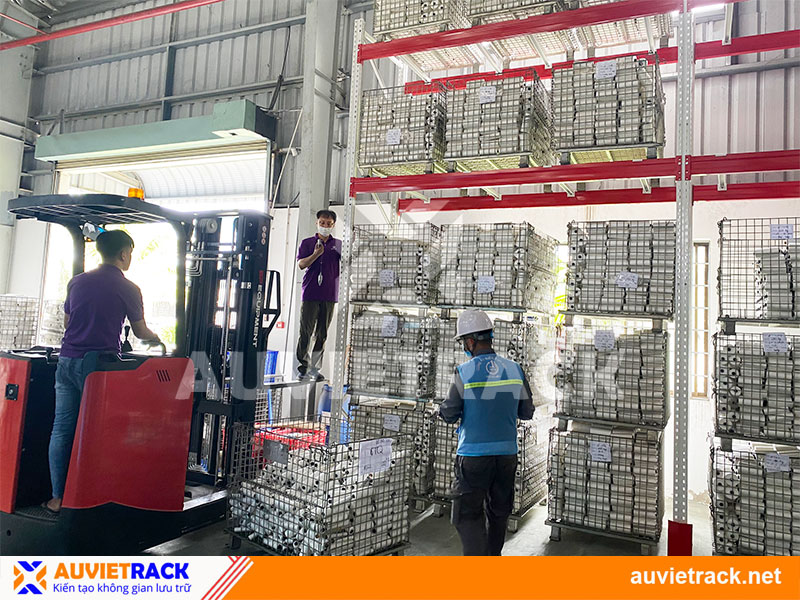 Selective and Double Deep racking have the same load capacity
Selective and Double Deep racking have the same load capacity
1.3 Way to arrange racking in the warehouse
Selective racking is arranged with 2 rows of single racking (1 row of double racking) in the middle of the warehouse. A row of single racking will be placed close to the wall for easy load and unload of goods. Aisles between rows of Selective racking require a minimum of 2750mm.
 How to arrange racking in the warehouse and minimal aisles
How to arrange racking in the warehouse and minimal aisles
Double Deep warehouse racking includes 2 rows of Selective racking (double rows of racking) placed together close to the wall, to facilitate the load and unload of goods, this type of rack is often arranged in rows of single racking. There needs to be a minimum distance of 3500mm between rows of racking to create a path for forklifts to enter and exit.
1.4 Storage density
This is the biggest difference between Selective racking and Double Deep racking. The storage density of Selective racking is not high because it requires many aisles for forklifts. racking can only utilize 40% of warehouse space.
Double Deep racking provides higher storage capacity. This is also considered the biggest advantage of Double Deep racking because it requires fewer forklift aisles. racking can utilize up to 65% of the warehouse floor area.
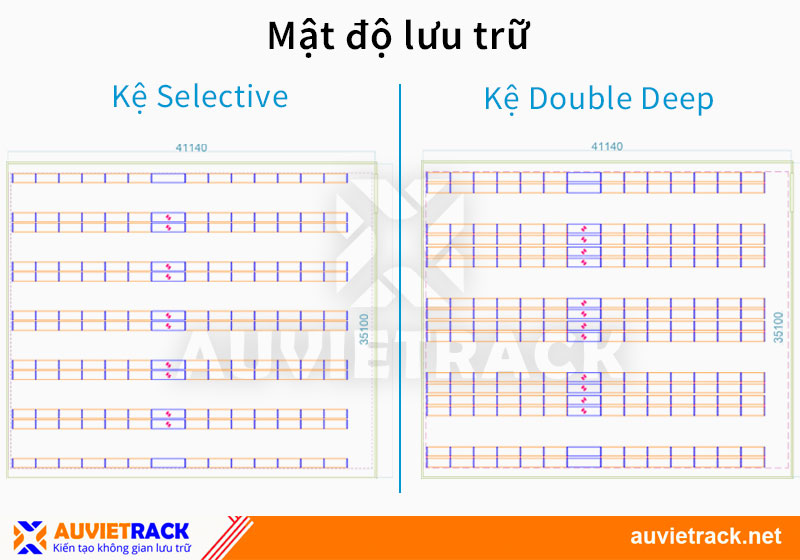 Compare the storage density of Selective racking and Double Deep racking
Compare the storage density of Selective racking and Double Deep racking
As shown in the picture above, we can see that in the same warehouse area, the number of rows of Double Deep racking can be placed more than the number of rows of Selective racking.
1.5 Maximum height of rack
The maximum safe height of both Selective racking and Double Deep racking is 12m.
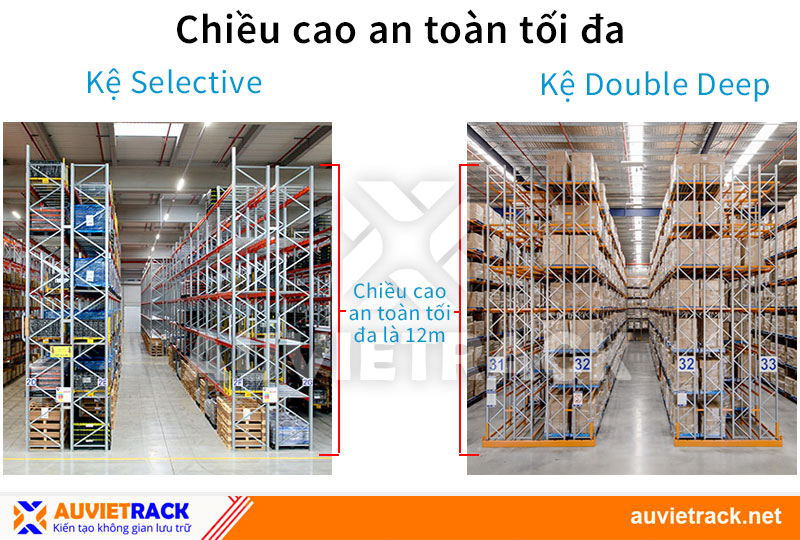 The maximum height of the two types of racking is the same
The maximum height of the two types of racking is the same
1.6 Accessibility of goods
Selective racking is more commonly used than other types of racking thanks to the advantage of allowing access to all pallets of goods in any location. It can be said that the accessibility of goods on Selective racking reaches 100%.
For Double Deep racking with a depth of 4 pallets for each row of racking, the ability to access goods is only 50%, making it difficult to access the 2nd and 3rd pallets. It can be understood that the pallets located outside will be easy to access, but when you want to take the inside pallets, you must move the outside pallets first.
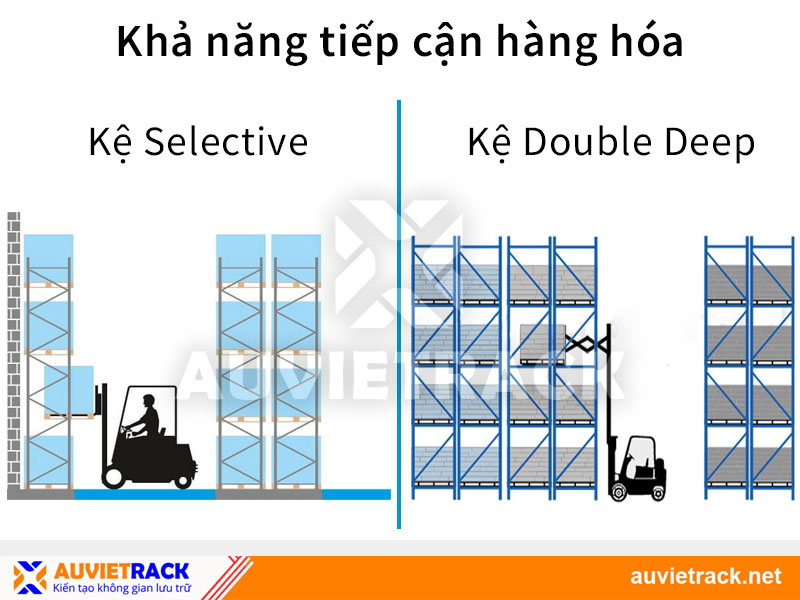 The accessibility of Selective racking is higher than Double Deep racking
The accessibility of Selective racking is higher than Double Deep racking
1.7 Load and unload principles
Selective racking allows load and unload of goods according to both LIFO and FIFO principles. Goods can be easily loaded and unloaded according to investors' needs thanks to maximum accessibility.
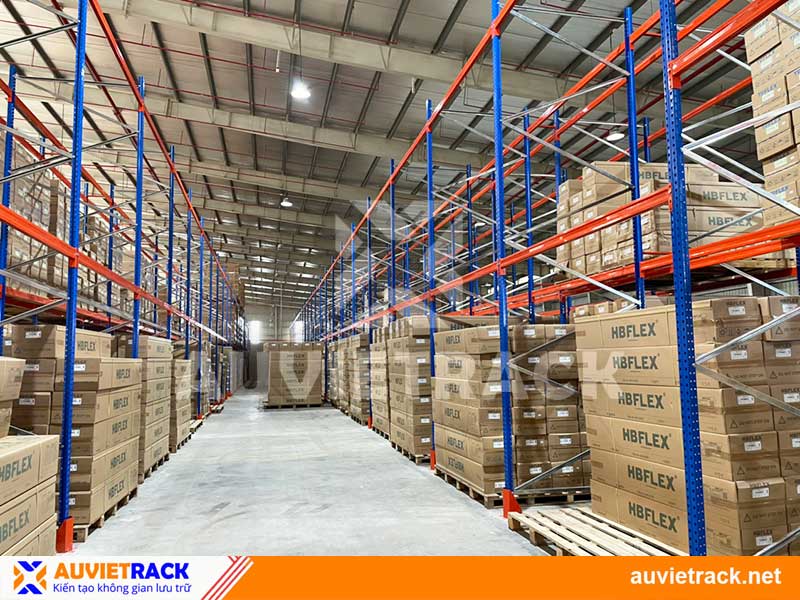 Selective racking can be loaded and unloaded according to both principles
Selective racking can be loaded and unloaded according to both principles
Double Deep racking can only apply the LIFO principle. Goods placed on the racking first will be placed in deeper positions, while goods placed last will be placed on the outside. Thus, when unloading goods, you need to get the outermost pallet first before you can get the inner pallets.
1.8 Forms of load and unload
Selective racking: Selective pallet racking is often used to store heavy and large pallets of goods, so the form of load and unload is forklifts of all kinds.
In addition, Selective racking also has many other types used with different rack lining materials. These materials can be mentioned as: Selective racking lined with boards, lined with corrugated iron, lined with mesh, grooved panels, etc. These types of Selective racking are often used to store small, light and discrete goods. Therefore, the main form of load and unload will be by hand combined with industrial mobile ladder.
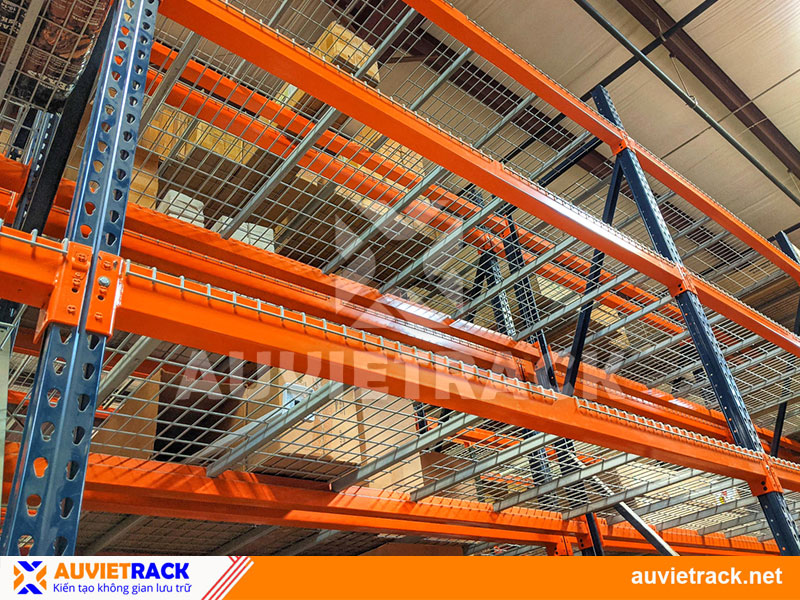 Selective mesh racking contains small and light goods
Selective mesh racking contains small and light goods
Double Deep racking: The main use of Double Deep racking is to store bulky goods with a large load, so when loading and unloading, you need to use a specialized forklift.
 Double Deep racking hold large and heavy goods
Double Deep racking hold large and heavy goods
1.9 Investment costs
This is one of the brightest advantages that makes Selective racking the most used type of racking today. The price of Selective racking is among the cheapest among warehouse racking. In addition, this type of rack does not require the use of specialized forklifts when loading and unloading, helping to save a lot of costs for investors.
 Compare the investment costs of Selective racking and Double Deep racking
Compare the investment costs of Selective racking and Double Deep racking
Because the structure of the Double Deep rack requires additional guide rails to be installed, the cost will be 15-20% higher than the Selective rack. In addition, the forklift for Double Deep racking must be a specialized high-cost forklift with forks that can be inserted deep into the rack to access the pallets inside. Therefore, the investment cost of Double Deep racking is significantly higher than that of Selective racking.
Summary table compares Selective racking and Double Deep racking most detailed
|
Comparison Criteria |
Selective racking |
Double Deep racking |
|
Structure |
Includes 7 basic components |
Similar to Selective racking but with additional rails |
|
Load capacity |
300-2000kg/pallet |
300-2000kg/pallet |
|
Storage density |
Not high |
High |
|
Use of storage space |
40% |
65% |
|
The layout |
In the middle of the warehouse: 2 rows of single rack |
In the middle of the warehouse: 2 rows of double rack |
|
Maximum height |
12m |
12m |
|
Ability to access goods |
100% |
50% |
|
Load and unload principle |
FIFO, LIFO |
LIFO |
|
Way to load and unload |
Forklift, manual or mobile ladder |
Specialized forklift |
|
Initial cost |
Both racks and forklifts are cheap |
Both racks and forklifts are expensive |
|
Forklift types |
Forklift |
Reach Truck |
|
Aisle between racks |
Need a lot of aisles between racks |
Reduce the number of aisles between racks |
Selective racking and Double Deep racking? Which one should be purchased?
Depending on the needs and types of goods in the warehouse, each type of rack will promote its optimal use.
If the enterprise owns a large warehouse, needs fast and continuous load and unload speed, goods in and out of certain sequence, goods with short shelf life and need to save costs, Selective rack is the best choice.
>> See more about the application of the Selective rack
 Selective racking for a large warehouse, need to load and unload quickly
Selective racking for a large warehouse, need to load and unload quickly
If the warehouse of the business is not too wide, it is necessary to take advantage of the space to store more pallets, load and unload according to the order "Last in First out", goods have longer shelf life and do not require speed. Fast load and unload, the best choice will be Double Deep rack.
>> See more about the application of the Double Deep rack
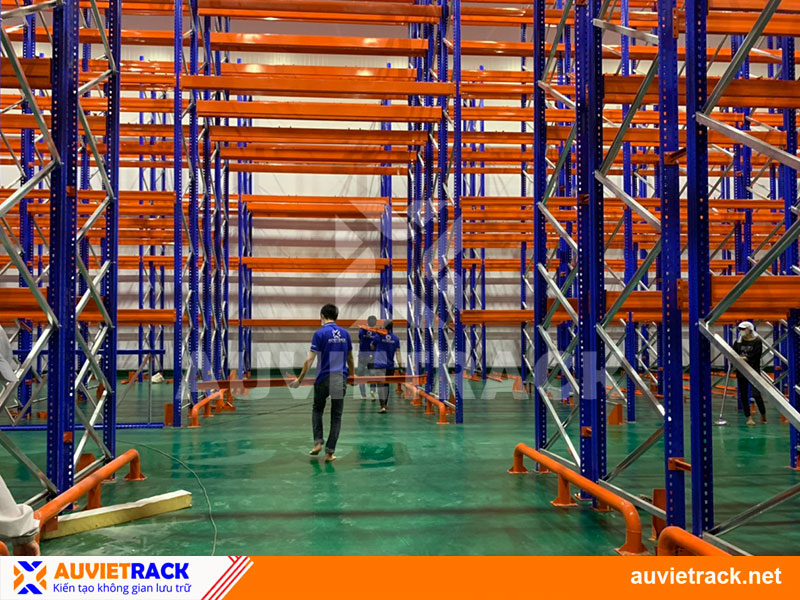 Double Deep racking for warehouses that need high storage density
Double Deep racking for warehouses that need high storage density
Above are the distinct characteristics between the two types of Selective and Double Deep racking. Au Viet Rack hopes to provide the most objective look and help customers better understand these two racking systems. If you have any questions, please contact Au Viet Rack immediately for advice quickly and dedicatedly.
